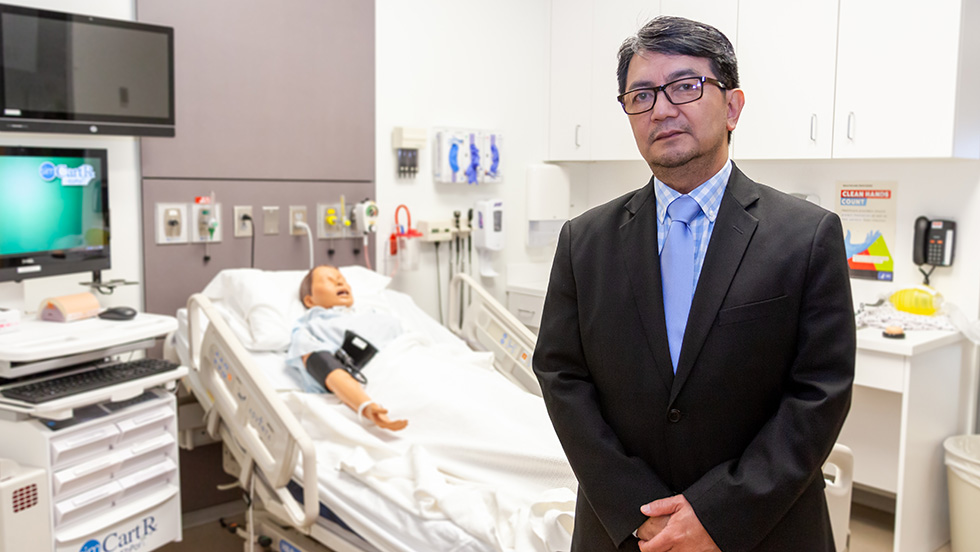
According to nurse.org, 80 percent of nurses say their patient care units are inadequately staffed, and almost 90 percent felt burned out in the past year. America’s nursing shortage is in need of a new solution, which inspired Professor Edmund J.Y. Pajarillo, PhD, to find one. Read what he and other nurse educators recommend to support the nursing workforce by increasing the number of nurse educators.
It is fairly well-known that there is an ongoing shortage of nurses in the United States. What isn’t understood, though, is that one of the major reasons for it is a shortage of nurse educators.
It’s a problem that is causing nursing schools to turn away qualified students for lack of faculty, clinical resources and support from various stakeholders in healthcare.
In response to this pressing issue, Professor Edmund J.Y. Pajarillo, PhD, of the Adelphi University College of Nursing and Public Health, has founded the National Consortium of Academic Nurse Educators (NC-ANE), an organization whose mission is to serve as an advocate for nurse educators through research, organizing and collaboration.
The College of Nursing and Public Health is also working to address the nursing shortage by offering a PhD in Nursing program as well as a Doctor of Nursing Practice program. Students in the doctoral programs also benefit from a grant program that cancels up to 85 percent of their loans for tuition once they receive a full-time faculty position.
We spoke to Dr. Pajarillo to learn more about founding the NC-ANE and how the organization aims to address the current nursing shortage.
What are the causes of the current nursing shortage?
There really aren’t enough teachers to serve the influx of nursing students. It’s been documented that schools have had to turn away potentially qualified students because they don’t have enough faculty or other resources to accommodate everyone. On top of that, another 80 percent of nursing faculty will be retiring in 2025, because most faculty members are baby boomers.
Many solutions to the nursing shortage have been proposed, but they’ve been created in silos. Specifically, there are five stakeholder groups involved, each with their own needs: educational institutions, healthcare systems, professional nursing organizations, policymakers and consumers of healthcare.
Academic institutions suggest increasing adjunct faculty, for example, but many adjunct faculty members lack the pedagogical skills necessary for successful teaching, have too many roles to juggle and do not receive employee benefits. Many full-time nursing faculty are also overworked. They’re expected to teach, advise and mentor students, conduct research, and perform service work inside and outside of school. Meanwhile policymakers pass bills to provide money to nursing schools, but we can’t always track how that money is used.
How did you come up with the idea for the NC-ANE?
I posted in an open forum for professional nurse educators, suggesting that we think of collaborative, multifaceted and innovative ways to address the nursing shortage—instead of continuing to operate in silos. To my surprise, over 100 people from across the U.S. responded to my post in agreement.
After an initial Zoom brainstorming session, we split into five groups, representing each stakeholder group. Each group conducted qualitative research, shared their personal experiences and reviewed literature related to the nursing shortage. We used our findings to create resolutions and recommendations for each stakeholder group.
In the end, there were 28 of us who completed this research. We were the founding members of the NC-ANE.
How does the NC-ANE aim to help address the nursing shortage?
Once we created our resolutions, we wrote campaign letters addressed to stakeholders, asking them to collaborate with us on solutions addressing the nursing faculty shortage. We encouraged others to use these letters as templates and help us in campaigning.
We also wrote manuscripts for the research we created for each of the five resolutions. One has been published, two are in press and one is in revision.
We’ve been accepted to present our resolutions at various conferences, including the Western Institute of Nursing Conference in Utah, the Eastern Nursing Research Society Conference in Boston, and the Sigma Theta Tau International Honor Society of Nursing Research Congress in Singapore.
Who is involved in the NC-ANE?
I am the founder and inaugural president. The chair of the research committee is Edwin-Nikko Kabigting, PhD, assistant professor here at the College of Nursing and Public Health. Adelphi is leading this group, but the organization and board of directors are comprised of members from schools across the nation.
This organization is collaborative in nature. We are recruiting members, but we are very selective. We envision growing to about 200–300 members in total.
What is your hope for the future of the NC-ANE and its impact on the nursing profession?
We recently gained nonprofit status, which will truly help us advance our mission of advocating for academic nurse educators. It will also help mobilize our community organizers and fund our research.
It’s expensive to hire more full-time nursing faculty, of course. But collaborative effort involving all the stakeholders—educational institutions, healthcare organizations, professional organizations, policymakers and consumers of healthcare—can help resolve the shortage of nurses and nursing faculty.
In September 2023, the U.S. Senate actually introduced a bill to increase nursing faculty (S.2815 – Nurse Faculty Shortage Reduction Act of 2023), and the House of Representatives introduced a companion bill in January. We’re hoping that more politicians recognize that this nursing shortage is a priority. As we wrote in one of our letters, “You don’t want to be sick and find that no one comes to your bedside when you ring a bell and ask for help.”